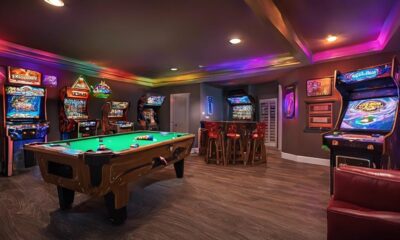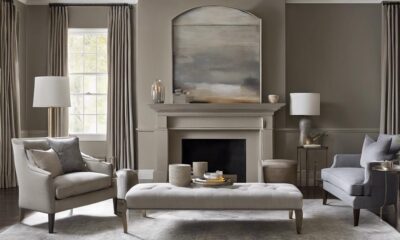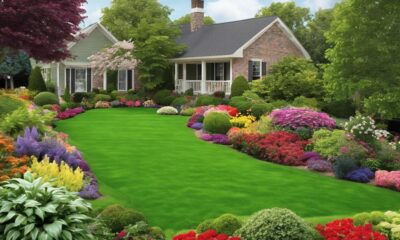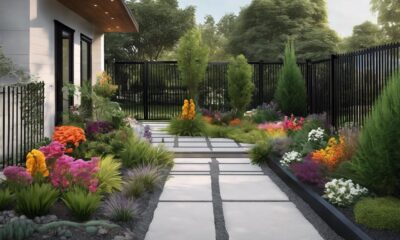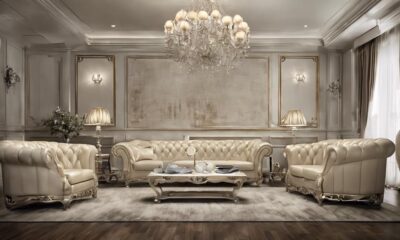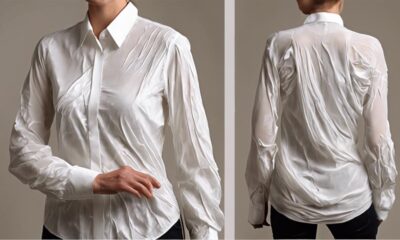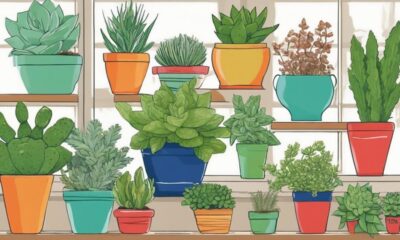Architecture Home Styles
Ultimate Guide to Your Home Beverage Bar Setup
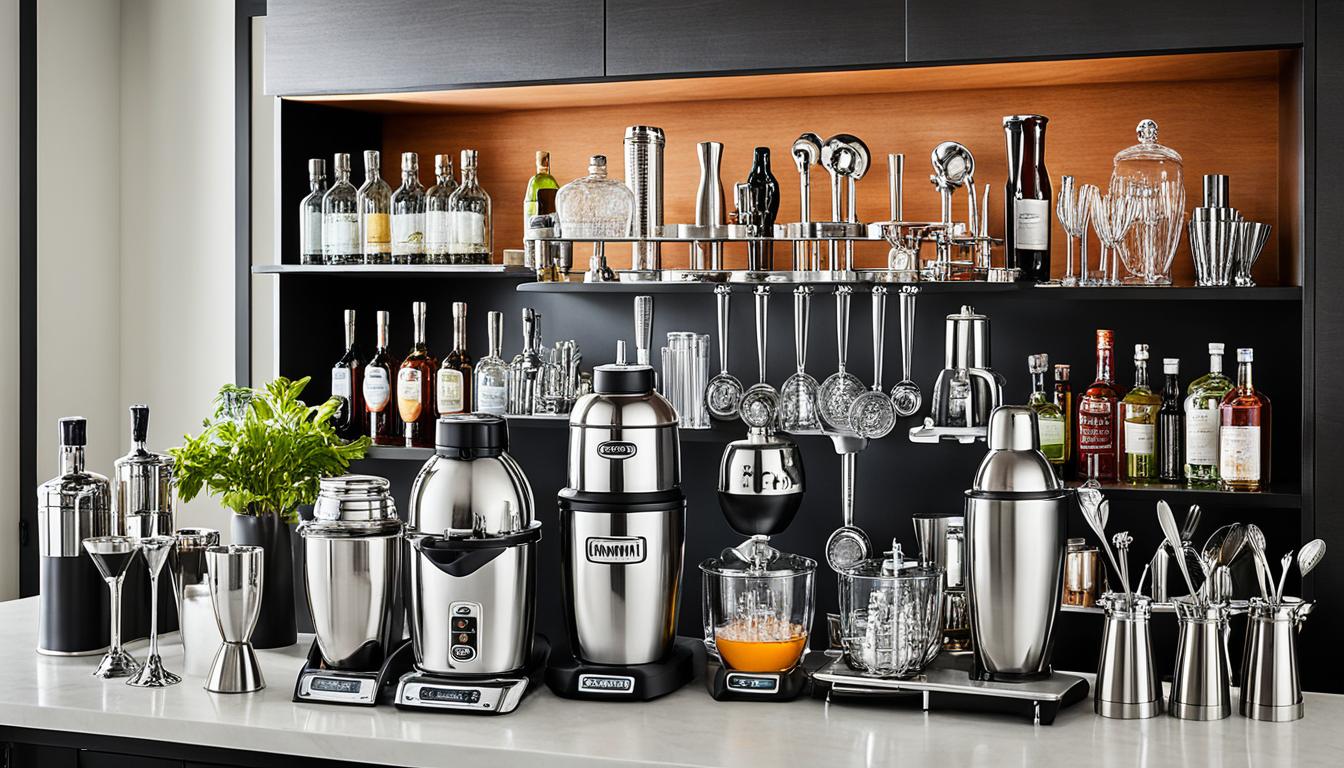
Welcome to the ultimate guide for creating the perfect home beverage bar setup! Did you know that having a well-stocked home bar is not only a stylish addition to your living space but also a practical way to entertain your guests? According to a recent survey, 87% of Americans believe that having a home bar enhances their socializing experience and makes them feel more confident as hosts. Whether you’re a seasoned mixologist or a casual cocktail enthusiast, we’ve got you covered with everything you need to know to create a home bar that will impress your guests and elevate your entertaining game.
Key Takeaways:
- Creating a well-stocked and stylish home beverage bar can enhance your socializing experience.
- Having a home bar makes you feel more confident as a host.
- This ultimate guide will walk you through everything you need to know to set up your home bar.
- Learn about choosing the perfect location, essential spirits, glassware and barware, mixers and liqueurs, wine storage and serving, personalizing your home bar, and creative alternative setups.
- Make your home bar setup truly yours by adding personal touches and decorations.
Choosing the Perfect Location for Your Home Bar
When setting up your home bar, it’s important to choose the right location. Consider designating an area in your home where you do most of your entertaining, such as the living room, dining area, or off the kitchen. This way, you can be part of the action and easily serve your guests.
Evaluate your space and determine whether you need cabinets with closed shelves, open shelving, or a combination of both for storing your bar tools, equipment, and spirits. Additionally, consider adding a small bar refrigerator or wine chiller for added convenience and luxury.
Having your home bar in a central location ensures that you’re always present and accessible to your guests. It allows you to engage in conversations, offer drink recommendations, and showcase your mixology skills. Plus, being in the heart of the entertainment area enhances the overall ambiance and creates a sense of togetherness.
In addition to the location, storage is a crucial aspect of any home bar setup. Cabinets with closed shelves help keep your bar tools and spirits organized and protected from dust and light. Open shelving provides easy access to frequently used items and can also showcase your spirits collection, adding a decorative touch to your home bar. A combination of both allows for versatile storage options.
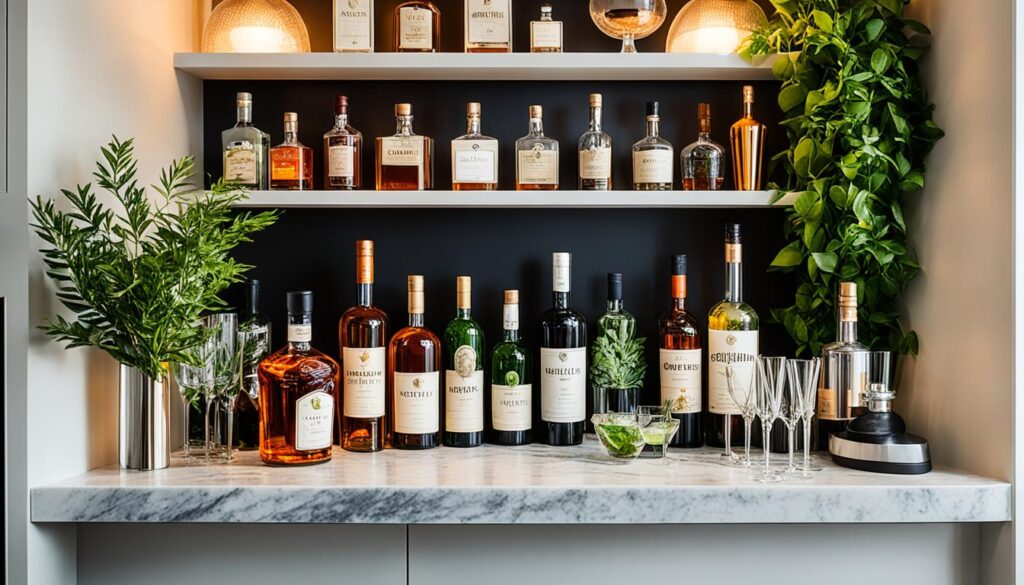
Consider including a small bar refrigerator or wine chiller in your home bar setup. This not only keeps your beverages chilled to perfection but also adds a touch of luxury and convenience. You can store wine, mixers, and other perishables at the ideal temperature, ensuring that each drink is served at its best.
Choosing the perfect location for your home bar sets the stage for memorable gatherings and enjoyable evenings. It integrates your bar seamlessly into the overall entertainment area, making it a focal point of your home. Take the time to evaluate your space, consider your storage needs, and add those extra touches that will make your home bar truly exceptional.
Essential Spirits for Your Home Bar
To create a well-rounded home bar, it’s important to stock up on essential spirits. These staple spirits will serve as the foundation for many classic cocktails and provide a range of options for your guests to enjoy. Invest in high-quality spirits within your budget and gradually expand your collection as your tastes evolve.
Here are the key spirits that you should consider stocking in your home bar:
- Vodka
- Gin
- Rum
- Tequila
- Whiskey
These spirits offer a wide range of flavor profiles and versatility, allowing you to create a variety of cocktails to suit different preferences. Whether it’s a refreshing gin and tonic, a classic vodka martini, or a rich and smoky whiskey sour, having these spirits on hand will ensure that you’re well-equipped to mix up a memorable drink.
When stocking your home bar, aim for a balance between quality and affordability. Look for reputable brands and explore different expressions within each spirit category. This way, you can find your preferred style while keeping your budget in check.
Remember to store your spirits properly to preserve their flavors. Keep them in a dark cabinet or on a bar cart away from direct sunlight. Excessive exposure to light and heat can degrade the quality of the spirits over time.

“A well-stocked home bar starts with a solid foundation of essential spirits.”
With these staple spirits in your collection, you’ll have a versatile range of options to serve at your home bar. Whether you’re mixing cocktails for a celebration or enjoying a quiet evening with a neat pour, these spirits will ensure that your home bar is always ready to impress.
| Spirit | Suggested Brands |
|---|---|
| Vodka | Grey Goose, Tito’s, Absolut |
| Gin | Tanqueray, Hendrick’s, Bombay Sapphire |
| Rum | Bacardi, Mount Gay, Diplomatico |
| Tequila | Patrón, Don Julio, Casamigos |
| Whiskey | Jack Daniel’s, Jameson, Makers Mark |
Exploring Different Styles
While the staple spirits mentioned above provide a solid starting point, don’t be afraid to experiment with different styles and variations. Consider adding a few additional spirits to your collection to further expand your cocktail repertoire. Some popular options to consider include:
- Scotch whisky
- Bourbon
- Cognac
- Brandy
- Amaretto
These spirits offer unique flavors and profiles that can add depth and complexity to your cocktails. From the smoky and peaty notes of Scotch whisky to the rich and caramel tones of bourbon, these spirits provide endless opportunities for creativity.
Remember, building a well-stocked home bar is a journey. Take your time to explore different spirits, experiment with new cocktail recipes, and most importantly, enjoy the process of building your own personal haven for libation.
Glassware and Barware Essentials for Your Home Bar
Proper glassware and barware are essential for crafting the perfect cocktail. Invest in a variety of glassware, including rocks glasses, Collins glasses, wine glasses, and coup glasses. These different types of glasses are designed to enhance the aromas and flavors of spirits and cocktails. Alongside glassware, acquire essential bar tools like a shaker, strainer, jigger, pitcher, and bar spoon. These tools will help you mix and serve drinks like a pro.
Elevate Your Home Bar with the Right Glassware
Choosing the right glassware for your home bar is crucial to enhancing the drinking experience. Each type of glass is specifically designed to highlight the unique characteristics of different spirits and cocktails. Here are some essential glassware options for your home bar:
| Glassware Type | Description |
|---|---|
| Rocks Glass | A short and wide glass perfect for serving spirits neat or on the rocks. |
| Collins Glass | A tall, narrow glass commonly used for mixed drinks and cocktails. |
| Wine Glass | A stemmed glass designed to enhance the aromas and flavors of wine. |
| Coup Glass | A shallow, wide-rimmed glass ideal for serving champagne or cocktails. |
Investing in a variety of glassware will allow you to properly serve and enjoy a wide range of cocktails and spirits. Whether you’re sipping a fine whiskey, enjoying a refreshing gin and tonic, or indulging in a glass of wine, having the right glassware will elevate your home bar experience.
Essential Bar Tools for Mixing and Serving
Alongside glassware, it’s important to equip your home bar with the necessary tools to mix and serve drinks with precision and style. Here are some essential bar tools to consider adding to your collection:
- Shaker: A stainless steel shaker for mixing cocktails and creating the perfect frothy texture.
- Strainer: A tool to separate the liquid from the ice and other solid ingredients when pouring cocktails.
- Jigger: A measuring tool with different measurement markers to ensure accurate pours.
- Pitcher: A large vessel for mixing larger batches of cocktails or serving drinks to a crowd.
- Bar Spoon: A long, twisted spoon used for stirring cocktails and layering ingredients.
Having these essential bar tools at your disposal will not only make cocktail preparation easier but also enable you to showcase your mixology skills to your guests. With the right glassware and barware, you’ll be ready to create impressive cocktails and serve them in style.

Mixers and Liqueurs for Your Home Bar
In order to create a wide variety of delicious cocktails, it is essential to have a selection of mixers and liqueurs on hand for your home bar. These versatile ingredients will add depth, flavor, and complexity to your drinks, allowing you to impress your guests with your mixology skills. Let’s explore the essential mixers and liqueurs that every home bar should have:
Essential Mixers
Start by stocking up on a few essential mixers that can be used in a variety of cocktails. These non-alcoholic beverages are the perfect complement to your spirits, helping to balance the flavors and bring out the best in each cocktail. Here are some must-have mixers for your home bar:
- Club soda
- Juices (such as orange, cranberry, and pineapple)
- Cola
- Tonic water
These mixers can be used in classic cocktails like the Tom Collins, Screwdriver, and Cuba Libre, as well as in your own creative concoctions. Feel free to experiment with different ratios to find the perfect balance of flavors.
Essential Liqueurs
In addition to mixers, having a selection of essential liqueurs in your home bar will take your cocktails to the next level. Liqueurs are alcoholic beverages flavored with herbs, fruits, spices, or nuts, and they can add complexity, sweetness, or bitterness to your cocktails. Here are some must-have liqueurs for your home bar:
- Vermouth
- Bitters
- Orange liqueur (such as Cointreau or triple sec)
These liqueurs can be used in classic cocktails like the Martini, Negroni, and Margarita, as well as in a wide range of other cocktails. The addition of these liqueurs will add unique flavors and aromas to your creations, making them truly exceptional.

Expand Your Collection
As you gain more experience in mixology and explore new cocktail recipes, you may find yourself wanting to expand your collection of mixers and liqueurs. There is a vast world of flavors out there, waiting to be discovered. Consider adding other mixers like ginger beer, cranberry juice, and sparkling water, as well as other liqueurs like amaretto, coffee liqueur, and herbal liqueurs like Chartreuse.
Remember, building your home bar is an ongoing journey. Take your time to explore different spirits, mixers, and liqueurs, and find the combinations that you enjoy the most. With the right mixers and liqueurs at your disposal, you’ll be able to create a wide range of flavorful and impressive cocktails, ensuring that your home bar becomes the go-to spot for friends and family.
Storing and Serving Wine in Your Home Bar
If you enjoy drinking wine, it’s important to have the right setup for storing and serving it in your home bar. Wine storage plays a crucial role in preserving the quality and taste of your favorite bottles. Here are some tips and essentials to consider:
- Invest in a wine storage cabinet or wine chiller:
- A wine storage cabinet with closing doors provides the ideal conditions for long-term wine storage. It protects your wine from harmful sunlight and temperature fluctuations.
- A wine chiller is perfect for those who want to enjoy their wine at the right serving temperature. It allows you to store wine bottles at a specific temperature, ensuring they are ready to be served when you desire.
- Choose the right wine accessories:
- A quality bottle opener is a must-have tool for any wine enthusiast. Look for options that are easy to use and provide a clean cork removal.
- An aerator can enhance the flavors and aromas of your wine. It allows the wine to breathe, bringing out its full potential.
- A decanter is used to separate the wine from any sediment and helps to aerate the wine.
- Consider the variety of wines to stock:
- Include a selection of red and white varietals to cater to different preferences. Some popular options include Cabernet Sauvignon, Merlot, Chardonnay, and Sauvignon Blanc.
- Store your wines in a cool and dry place, away from direct sunlight and heat sources.
Remember, proper wine storage and serving can greatly enhance the taste and enjoyment of your favorite bottles. With the right setup and tools, you can create a delightful wine experience for yourself and your guests.
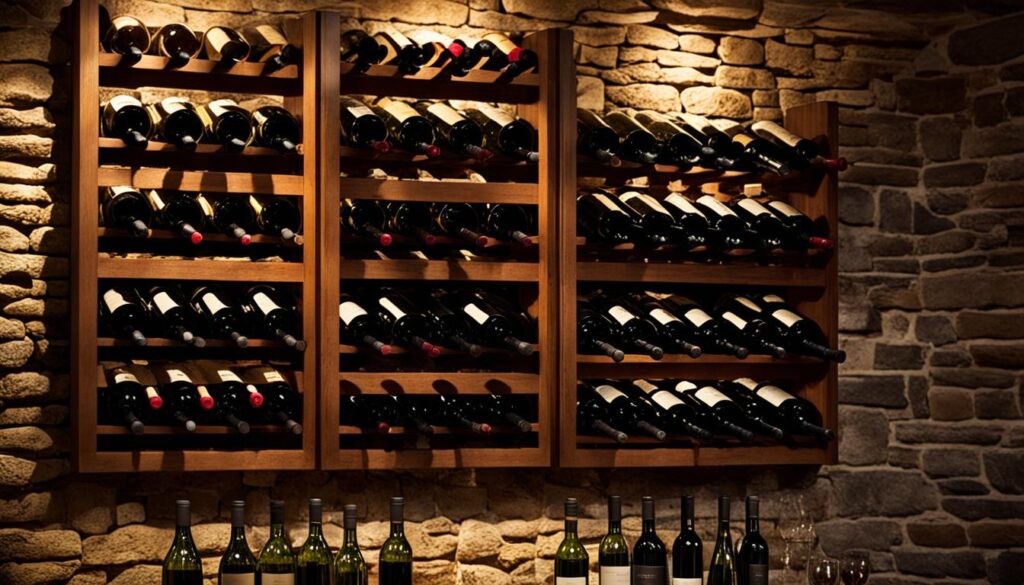
Garnishes and Extras for Your Home Bar
Adding garnishes and extras is a fantastic way to elevate your home bar setup and impress your guests. These finishing touches not only enhance the visual appeal of your drinks but also add a burst of flavor and aroma. Let’s explore some essential garnishes, extras, and accessories that will take your home bar to the next level.
Garnishes:
Consider stocking up on the following garnishes to add a delightful twist to your cocktails:
- Olives: Perfect for martinis and savory drinks.
- Lemon and Lime Wedges: Ideal for adding a refreshing citrus kick.
- Maraschino Cherries: Classic accompaniment to sweet cocktails.
- Herbs: Rosemary and mint can bring a touch of freshness to your concoctions.
Experiment with different combinations to find out which garnishes best complement the drinks you plan to serve. Your guests will appreciate the attention to detail and the vibrant flavors.
Extras and Accessories:
Aside from garnishes, consider providing your guests with these extras and accessories:
- Cocktail Napkins: A stylish and practical addition that adds a touch of sophistication.
- Coasters: Protect your bar and furniture while adding a decorative element.
To personalize your home bar and make it truly unique, consider incorporating artwork, plants, or flowers that match your home’s decor. These elements not only create an inviting ambiance but also serve as excellent conversation starters.
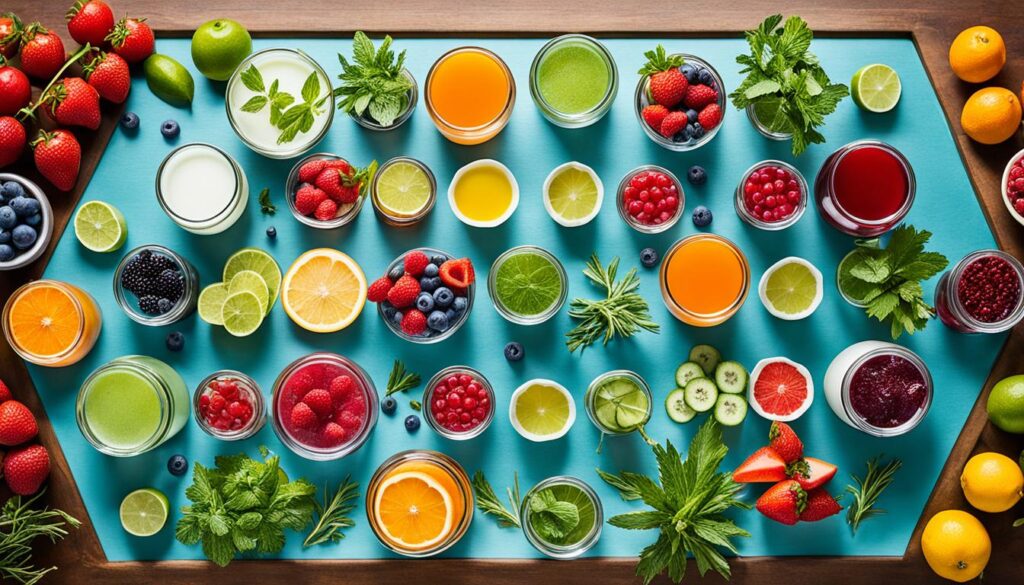
Now that you know the importance of garnishes and extras, let’s move on to exploring some creative alternatives for your home bar setup in the next section.
Creative Alternatives for Home Bar Setup
Not every home has the space or the need for a traditional home bar setup. At times, thinking outside the box and getting creative can lead to unique and stylish alternatives for your home bar. Here are some ideas to inspire your creative home bar setup:
Repurpose Existing Furniture
If you’re short on space or looking for a budget-friendly option, consider repurposing furniture you already own to house your bar essentials. A sideboard or an armoire can be transformed into a stylish and functional home bar. Utilize the shelves and drawers to store your glassware, spirits, and bar tools. This alternative setup not only saves space but also adds character to your home.
Impromptu Bars in Small Corners
Even the smallest corners of your home can be transformed into a charming bar setup. Folding TV trays can serve as impromptu bars that can be easily set up and put away when not in use. Place a decorative tray with your favorite spirits, glassware, and bar tools on the tray table, and you have a portable bar that can be moved around as needed. This is a perfect option for those who love entertaining in different areas of their home.
Versatility of Different Spaces
Embrace the versatility of different spaces in your home to create a unique home bar setup. The living room, basement, garage, or outdoor areas can all be utilized to set up a bar that suits your style and needs. Opt for a sleek bar cart in the living room for a touch of elegance, convert a corner of your basement into a rustic home bar, or transform your garage into a sports-themed bar for game day gatherings. The possibilities are endless!
Thinking creatively and exploring alternative options allows you to customize your home bar setup to fit your space and lifestyle. Whether it’s repurposing furniture, setting up impromptu bars in small corners, or utilizing different spaces in your home, the key is to make it personal and reflective of your unique style.
With a little ingenuity and creativity, you can create a home bar setup that is both functional and visually appealing. So let your imagination run wild and design a home bar that truly stands out!
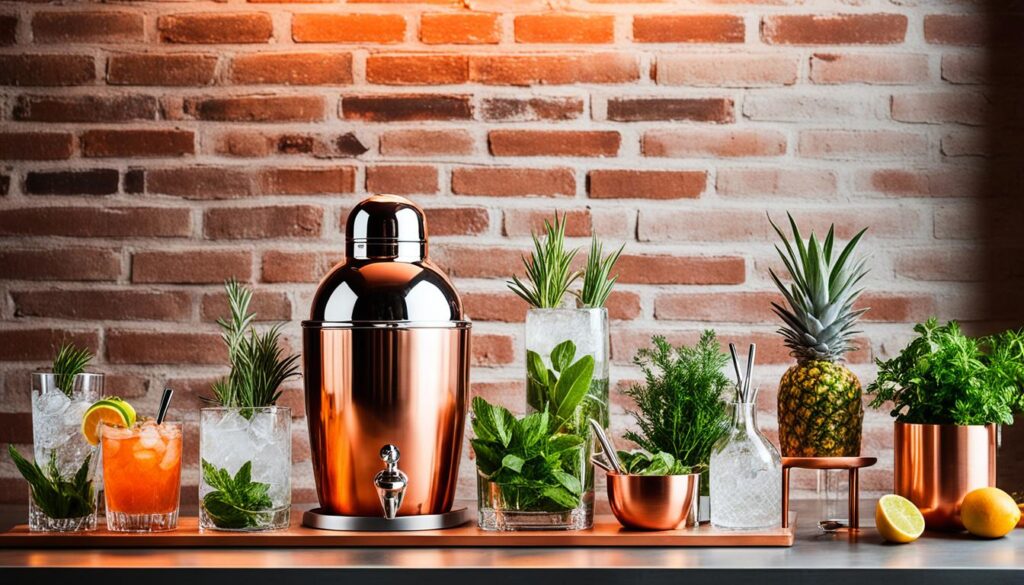
| Alternative Home Bar Ideas | Description |
|---|---|
| Repurpose Existing Furniture | Transform a sideboard or armoire into a stylish home bar. |
| Impromptu Bars in Small Corners | Use folding TV trays to create portable bars in small spaces. |
| Versatility of Different Spaces | Utilize various areas of your home, such as the living room, basement, garage, or outdoor areas, to create unique home bar setups. |
Personalizing Your Home Bar
Make your home bar setup truly yours by adding personal touches and decorations. Create a space that reflects your unique personality and style. By incorporating special items, artwork, and accessories, you can infuse your home bar with character and create a welcoming atmosphere for your guests.
Display Unique and Sentimental Items
Turn your home bar into a conversation starter by showcasing unique and sentimental items that hold significance to you. These items can serve as a reflection of your personality and make your home bar feel more personal.
Consider displaying:
- Memorabilia from special events or travels
- Family heirlooms or antique barware
- Photographs or artwork that inspire you
- Mementos from your favorite cocktail experiences
Add Greenery and Freshness
Bring life to your home bar by incorporating plants or fresh flowers. Not only do they add a touch of nature, but they also enhance the overall aesthetic appeal.
Choose low-maintenance plants like succulents or herbs that can be used as garnishes for your cocktails. Place them strategically to create a visually pleasing arrangement.
Include Stylish Bar Accessories
A well-stocked home bar is not complete without the right accessories. Invest in bar tools and accessories that not only provide functionality but also match your personal style.
Consider adding:
| Bar Accessories | Description |
|---|---|
| Vintage Mallets | Unique and stylish mallets for muddling ingredients |
| Ice Picks | Accessorize your bar with vintage-inspired ice picks |
| Cocktail Picks | Opt for decorative picks that add a touch of elegance to your garnishes |
Mix and Match Glassware
Elevate your home bar’s visual appeal by using a variety of glassware. Mix and match different styles and sizes to create an eye-catching display.
Choose glassware that not only complements your cocktails but also adds a touch of sophistication to your home bar setup.
Follow a Coordinated Color Story
Create a cohesive look by following a color story in your home bar. Choose colors that enhance the surrounding room and match your home’s decor.
Coordinate the colors of your glassware, accessories, and decorations to create a pleasing aesthetic that ties the space together.
An Inspiring Example
“My home bar is a reflection of my love for travel and vintage aesthetics. I’ve adorned the walls with vintage maps and framed photographs from my favorite destinations. Alongside a display of antique cocktail tools, I’ve placed a small collection of antique liquor bottles that I’ve collected over the years. The colors of my glassware and bar accessories are inspired by the rich tones of a classic globe, adding warmth and character to the space. These personal touches have transformed my home bar into a true conversation starter.” – Sarah, Home Bar Enthusiast
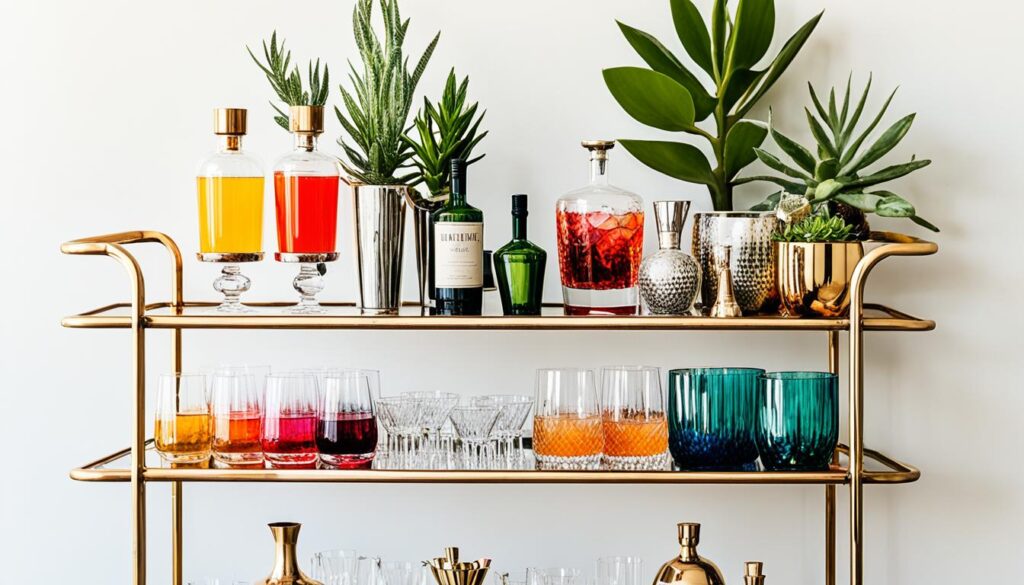
Adding personal touches to your home bar setup is a fun and creative way to make it uniquely yours. Whether it’s displaying sentimental items, incorporating greenery, or curating stylish bar accessories, these small details will elevate your home bar and create a warm and inviting space for entertaining.
Conclusion
Creating a home beverage bar is a fun and rewarding project that allows us to entertain with ease and style. By choosing the right location, stocking essential spirits and mixers, investing in quality glassware and barware, and adding personal touches, we can create a home bar setup that reflects our taste and hospitality.
Throughout this guide, we have discussed the key elements of setting up a home bar, including selecting the perfect location, acquiring essential spirits and mixers, investing in quality glassware and barware, and personalizing the space. By following these tips, we can confidently entertain our guests and create unforgettable memories in our own home bar.
Remember, our home bar setup is a reflection of our personality, so don’t be afraid to get creative and add personal touches. Whether it’s displaying unique artwork, incorporating plants and flowers, or showcasing vintage bar accessories, these details will make our home bar setup stand out.
As we continue on our home bar journey, don’t forget to continuously expand our collection of spirits and mixers. Explore new cocktail recipes and techniques to keep things exciting and to further develop our mixology skills.
Thank you for joining us on this ultimate guide to your home beverage bar setup. Cheers to creating unforgettable memories with friends and family in our own home bar!
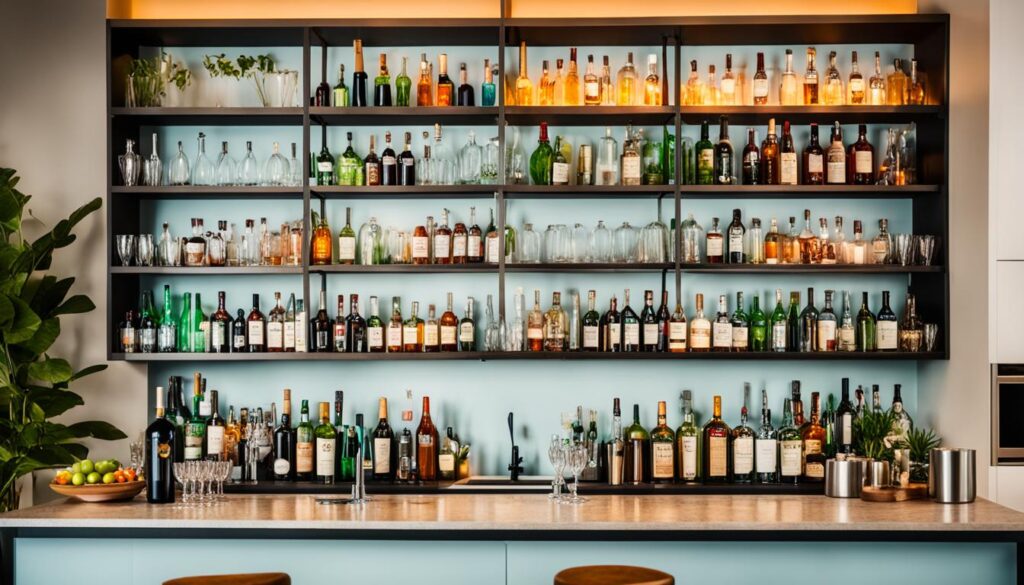
Additional Tips for Home Beverage Bar Setup
Setting up your home beverage bar can be an exciting project, and to ensure a smooth experience, we have a few additional tips for you:
– Label your bottles and create a system for organizing them. This will help you easily find the spirit or mixer you need, saving you time and reducing the chance of mistakes.
– Keep your bar area clean and well-organized. A clutter-free environment not only looks more appealing but also makes drink preparation easier. Have designated spaces for your tools, glassware, and ingredients to maintain order and efficiency.
– Invest in quality ice-making equipment or find a convenient source of ice nearby. The quality and consistency of ice can greatly enhance the taste and presentation of your cocktails. So, don’t overlook this essential element of your home bar setup.
– Don’t be afraid to experiment with different cocktail recipes and techniques. Explore new flavors, mixology trends, and presentation styles to expand your skills and impress your guests. Have fun in the process and let your creativity shine.
– Stay updated on the latest trends in spirits, cocktails, and barware. The world of mixology is constantly evolving, so be sure to keep an eye out for new spirits, innovative cocktails, and exciting barware accessories. This will keep your home bar setup current, vibrant, and delightful to both you and your guests.
By following these additional tips, you’ll be well on your way to creating a home beverage bar setup that is not only functional but also a reflection of your personal style and passion for entertaining. Cheers to your successful home bar setup!
When choosing the perfect location for your home bar, consider designating an area in your home where you do most of your entertaining, such as the living room, dining area, or off the kitchen. This way, you can be part of the action and easily serve your guests. Evaluate your space and determine whether you need cabinets with closed shelves, open shelving, or a combination of both for storing your bar tools, equipment, and spirits. Additionally, consider adding a small bar refrigerator or wine chiller for added convenience and luxury.
The essential spirits you should stock for your home bar include vodka, gin, rum, tequila, and whiskey. These spirits form the foundation for many classic cocktails and can be enjoyed neat or on the rocks. Invest in high-quality spirits within your budget and gradually expand your collection as your tastes evolve. Consider storing your spirits in a dark cabinet or on a bar cart away from direct sunlight to preserve their flavors.
The glassware and barware essentials you need for your home bar include rocks glasses, Collins glasses, wine glasses, coup glasses, a shaker, strainer, jigger, pitcher, and bar spoon. Invest in a variety of glassware that is designed to enhance the aromas and flavors of spirits and cocktails. These tools will help you mix and serve drinks like a pro.
For your home bar, start with a selection of mixers like club soda, juices, cola, and tonic water. These non-alcoholic beverages are versatile and can be used in various cocktails. Additionally, stock up on essential liqueurs like vermouth, bitters, and orange liqueur. These additions will add depth and complexity to your cocktails. Gradually expand your collection of mixers and liqueurs as you explore new cocktail recipes. If you enjoy drinking wine, it’s important to have the right setup for storing and serving it in your home bar. Consider investing in a cabinet with closing doors to protect your wine from sunlight and temperature fluctuations. Alternatively, a wine chiller is optimal for long-term storage. To fully enjoy each bottle, invest in a quality bottle opener, aerator, and decanter. Choose a variety of red and white varietals and store them in a cool and dry place.
To elevate your home bar setup and impress your guests, consider stocking up on garnishes like olives, lemon and lime wedges, maraschino cherries, and herbs like rosemary and mint. These garnishes can accompany or complement the drinks you intend to serve. Additionally, provide your guests with cocktail napkins and coasters for a stylish and practical touch. Spruce up your home bar with a piece of artwork, plants, or flowers that match your home’s decor.
If you don’t have the space or the need for a traditional home bar setup, get creative and think outside the box. Explore alternative options like repurposing furniture you already own, such as a sideboard or armoire, to house your bar essentials. Consider using folding TV trays for impromptu bars in small corners. Embrace the versatility of different spaces in your home, like the living room, basement, garage, or outdoor areas, to create your unique home bar setup.
Make your home bar setup truly yours by adding personal touches and decorations. Consider displaying unique and sentimental items that reflect your personality. Hang artwork, add plants or flowers, and include accessories like vintage mallets, ice picks, and cocktail picks. Mix and match glassware and choose pieces that spark joy and conversation. Follow a color story that enhances the surrounding room and matches your home’s decor. These personal touches will make your home bar setup stand out and create a welcoming atmosphere for your guests.
To keep your home bar area organized, label your bottles and have a system for organizing them. Keep your bar area clean and tidy, making drink preparation easier. Invest in quality ice-making equipment or find a convenient source of ice nearby. Experiment with different cocktail recipes and techniques to expand your mixology skills. Stay updated on the latest trends in spirits, cocktails, and barware to keep your home bar setup current and exciting. Here are a few additional tips for your home beverage bar setup: label your bottles and have a system for organizing them, keep your bar area clean and organized to make drink preparation easier, invest in quality ice-making equipment or find a convenient source of ice nearby, experiment with different cocktail recipes and techniques to expand your mixology skills, and stay updated on the latest trends in spirits, cocktails, and barware to keep your home bar setup current and exciting.
FAQ
How do I choose the perfect location for my home bar?
What are the essential spirits I should stock for my home bar?
What glassware and barware essentials do I need for my home bar?
What mixers and liqueurs should I stock for my home bar?
How do I store and serve wine in my home bar?
What garnishes and extras can I add to my home bar?
What are some creative alternatives for home bar setup?
How can I personalize my home bar?
How do I keep my home bar area organized?
What are some additional tips for home beverage bar setup?
- About the Author
- Latest Posts
Meet Bethia, the visionary designer at ByRetreat who brings a touch of magic to every remote workspace she creates. With a boundless imagination and an eye for beauty, Bethia is passionate about transforming ordinary spaces into extraordinary havens of creativity and comfort.
Bethia possesses a unique talent for envisioning the perfect combination of furniture, colors, and textures that harmonize seamlessly in a room. She understands that selecting furniture goes beyond mere functionality; it’s about curating pieces that evoke a sense of style and sophistication while enhancing the overall ambiance.
Architecture Home Styles
What Features Define a Two-Story House?
Open the door to explore the defining features of a two-story house, from its layout to design elements, offering a blend of functionality and aesthetics.
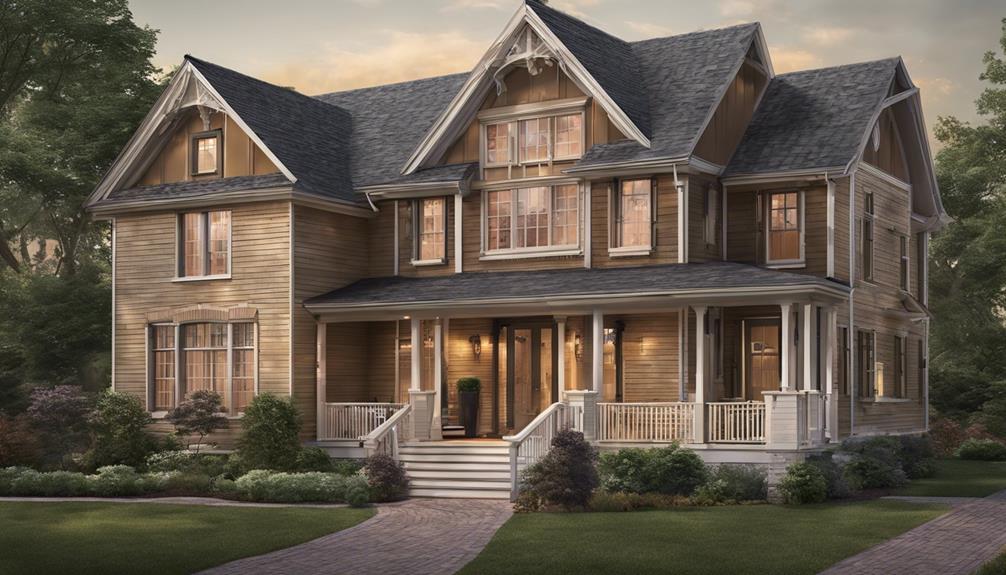
When considering the features that define a two-story house, it's essential to acknowledge the potential concern about accessibility and mobility issues. However, beyond this initial consideration, there are several key characteristics that set two-story houses apart and make them a popular choice for many homeowners.
From the layout and structural components to the design elements and advantages they offer, two-story homes present a unique blend of functionality and aesthetics that cater to diverse needs and preferences. The discussion on what truly defines a two-story house goes beyond mere physical attributes; it encompasses a lifestyle and practicality that continue to shape the appeal of these structures.
Key Takeaways
- Bedrooms on the second floor offer privacy and better views.
- Strategic division of living and sleeping spaces for efficient use.
- Lower building costs with more living space per square foot.
- Clear separation between communal areas and private retreats for balanced living.
Key Layout Characteristics
In a two-story house, the key layout characteristics focus on the strategic division of living and sleeping spaces to optimize privacy and space utilization. Bedrooms on the second floor provide a private retreat away from the hustle and bustle of the main living areas on the ground floor. The living area on the lower level serves as the central hub for daily activities, seamlessly connected to the dining area for convenience. By stacking these functions on separate floors, two-story houses make efficient use of a larger footprint, maximizing both indoor and outdoor space.
The upper level's design emphasizes natural light and clean lines, creating a modern and airy atmosphere. This floor often houses the bedrooms, ensuring a quiet and restful environment away from the more active entertainment spaces below. Two-story house plans are carefully crafted to balance functionality and aesthetics, offering a harmonious blend of privacy and communal living.
Structural Components Overview
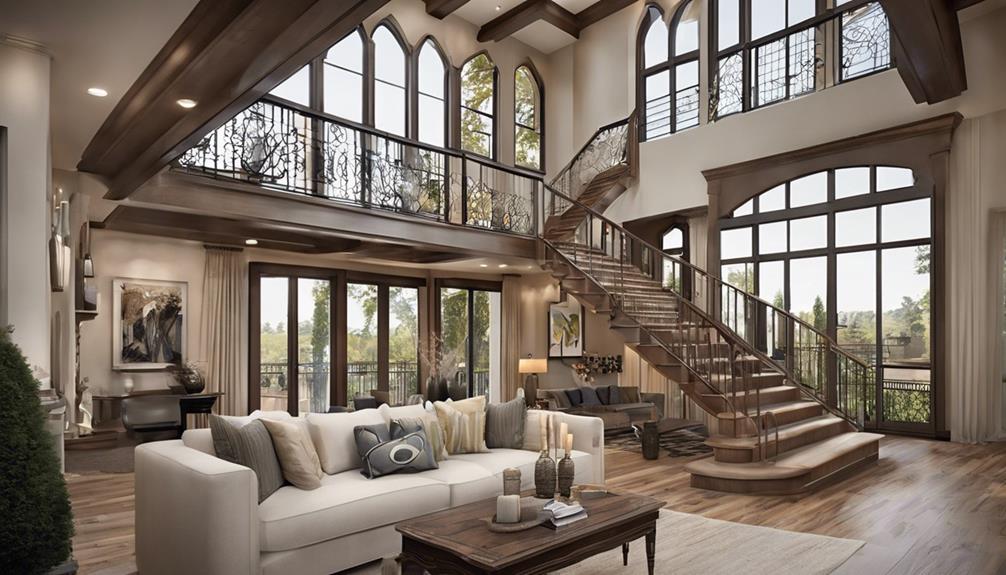
A two-story house's structural components encompass essential elements like load-bearing walls, floor joists, and a staircase interconnecting both levels. These components are vital for the stability and functionality of the home.
When considering the structural aspects of a two-story house, several key features come into play:
- Load-Bearing Walls: These walls support the weight of the upper floors and the roof, distributing the structural load effectively.
- Floor Joists: These horizontal beams provide support for the flooring on the second level, ensuring structural integrity and stability.
- Staircase: Connecting the ground floor to the second floor, the staircase not only provides access but also plays a role in distributing weight between the levels.
- Gable Roof: Often seen in two-story houses, the gable roof design not only adds aesthetic appeal but also contributes to efficient water runoff and structural strength.
- Foundation Design: The foundation of a two-story house must be carefully planned and constructed to support the additional weight of the second floor and ensure the stability of the entire structure.
Design Elements of Two-Story Houses
Exploring the design elements of two-story houses reveals intricate planning and strategic layout considerations that contribute to the overall functionality and aesthetic appeal of these homes. Two-story homes are characterized by a traditional layout where the ground floor typically houses the entrance, living areas, and dining spaces, while the second floor is primarily designated for bedrooms. This architectural design allows for a clear separation between the living and sleeping areas, offering residents increased privacy. Additionally, the placement of bedrooms on the second floor provides better views, enhancing the overall living experience within the home.
The design of two-story houses is carefully crafted to optimize space and create a harmonious flow between different areas of the home. By strategically arranging living spaces on the first floor and bedrooms on the second floor, these homes offer a balance between communal areas and private retreats. This thoughtful layout not only maximizes functionality but also contributes to the unique charm and appeal of two-story houses.
Advantages of Two-Story Homes
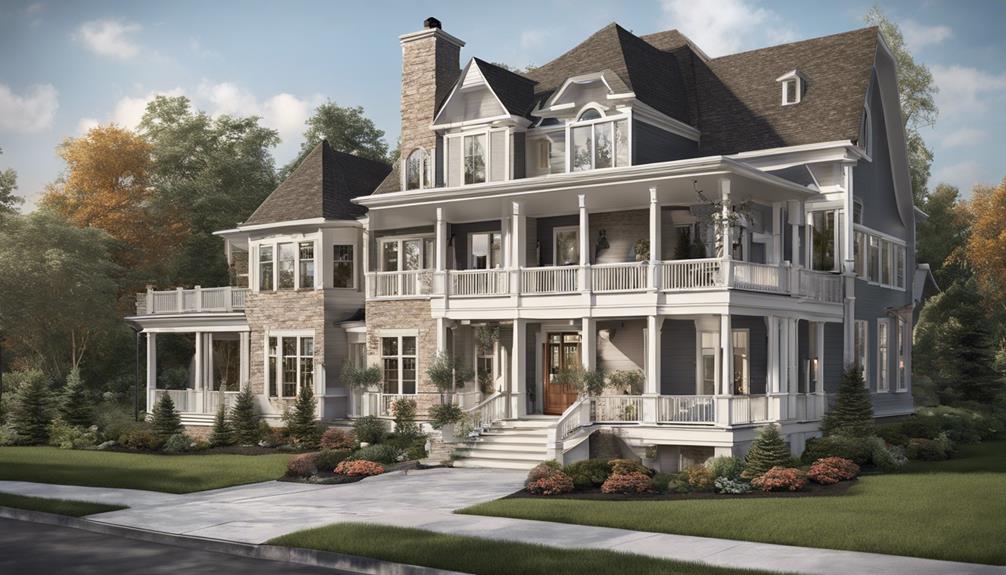
With lower building costs compared to one-story homes, two-story homes offer various advantages that appeal to homeowners seeking space efficiency and privacy. In addition to cost savings, two-story homes provide more living space per square foot of land due to their vertical design. The upper floor typically houses bedrooms, offering privacy and separation from the common areas on the first level. This layout allows for an open floor plan on the first level, creating a spacious and interconnected living area. Two-story homes also maximize outdoor space, offering better views from elevated levels.
- More living space
- Enhanced privacy with bedrooms on the upper floor
- Open floor plan on the first level
- Better utilization of outdoor space
- Flexibility in room arrangements and layouts
Furthermore, two-story homes present opportunities for design options such as incorporating a guest suite or a home office on the second floor. The smaller footprint of a two-story home allows for potential expansion in various areas to accommodate changing needs.
Considerations When Choosing a Two-Story House
Considering a two-story house requires thoughtful evaluation of its privacy benefits, safety considerations, building costs, and maintenance implications.
One of the main advantages when it comes to choosing a two-story house is the increased privacy that the upper floor offers, providing better views and separation from the outside world. However, it's crucial to weigh the potential safety issues, longer build time, and the need for stairs in a two-story home, especially if you have small children.
While two-story houses generally have lower building costs and require less foundation, they come with the trade-off of less usable square footage on the first floor. Maintenance implications should also be considered; a two-story house may require more effort to upkeep compared to a one-story home.
Ultimately, when deciding between a one-story or a two-story house, it's essential to balance the pros and cons to find a home that suits your lifestyle and preferences.
Frequently Asked Questions
What Qualifies as a 2-Story House?
We define a two-story house as a dwelling with two full floors, often with bedrooms on the second floor. The ground level typically encompasses the entrance, living, and dining areas. This design offers more space and privacy.
What Are the Features of a Two Story House?
We'll delve into the features of a two-story house, highlighting its distinct levels, offering privacy and space. Staircases connecting living and sleeping areas add architectural charm. Enhanced views, separation of functions, and a cozy feel are hallmarks.
What Is a Typical 2-Story House?
We find a typical 2-story house to be a dwelling with two levels, the ground floor for common areas and the second floor designated for bedrooms. This layout provides separation between living and sleeping spaces, offering more privacy and better views.
What Is the Definition of a Two Story Building?
We see a two-story building as a vertical canvas, where each floor serves a distinct purpose. The ground floor hosts daily activities, while the second floor offers privacy and rest. Stairs or an elevator connect these levels, maximizing space efficiency.
Conclusion
In conclusion, two-story houses offer a spacious layout, privacy, and a better view from the second floor.
While some may have concerns about accessibility for individuals with mobility issues, modern designs incorporate features like elevators or chairlifts to address these challenges.
The benefits of ample living space and separate sleeping areas outweigh the potential limitations, making two-story homes a desirable option for many families.
- About the Author
- Latest Posts
Introducing Ron, the home decor aficionado at ByRetreat, whose passion for creating beautiful and inviting spaces is at the heart of his work. With his deep knowledge of home decor and his innate sense of style, Ron brings a wealth of expertise and a keen eye for detail to the ByRetreat team.
Ron’s love for home decor goes beyond aesthetics; he understands that our surroundings play a significant role in our overall well-being and productivity. With this in mind, Ron is dedicated to transforming remote workspaces into havens of comfort, functionality, and beauty.
Architecture Home Styles
Top 3 Most Durable Wood Flooring Types
Marvel at the durability and beauty of oak, bamboo, and Brazilian walnut wood flooring types—discover which one reigns supreme for lasting elegance!
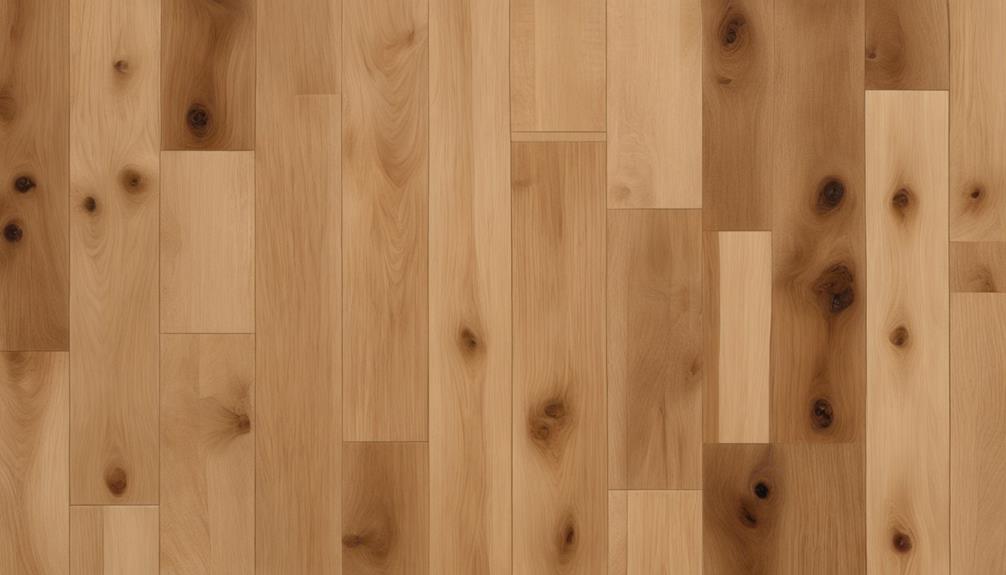
When it comes to choosing wood flooring that will last a long time, we are typically attracted to three main options. Each one offers its own unique qualities and charm.
From the timeless oak to the surprisingly resilient bamboo and the exotic Brazilian walnut, also known as Ipe, these top players in the wood flooring arena have much to offer.
But what sets them apart in terms of durability and longevity? Let's explore the nuances that make them the top choices for lasting beauty and functionality in our living spaces.
Key Takeaways
- Oak and hickory are top choices for durable wood flooring due to high Janka hardness ratings.
- Santos Mahogany offers exceptional strength and elegance, ideal for high-traffic areas.
- Bamboo's resilience and eco-friendliness make it a popular and durable flooring option.
- Brazilian Walnut (Ipe) stands out for its extreme durability, rich colors, and resistance to wear.
Oak: The Industry Standard
When it comes to durable wood flooring types, oak stands out as the industry standard due to its exceptional strength and resilience against wear and tear. Oak boasts a high Janka hardness rating, making it highly durable and resistant to dents and scratches. This makes it an ideal choice for high-traffic areas in homes or commercial spaces where longevity is crucial. Red oak and white oak are two common species used for oak flooring, both known for their durability and classic aesthetic appeal.
Oak wood flooring offers a range of finishes and colors, providing versatility in design options while maintaining its robust nature. Its timeless and classic appearance not only adds value to a home but also ensures that the flooring will withstand the test of time. Whether you prefer the warm tones of red oak or the subtle beauty of white oak, choosing oak flooring guarantees a durable and elegant solution for your space.
Hickory: The Hardest American Wood Species
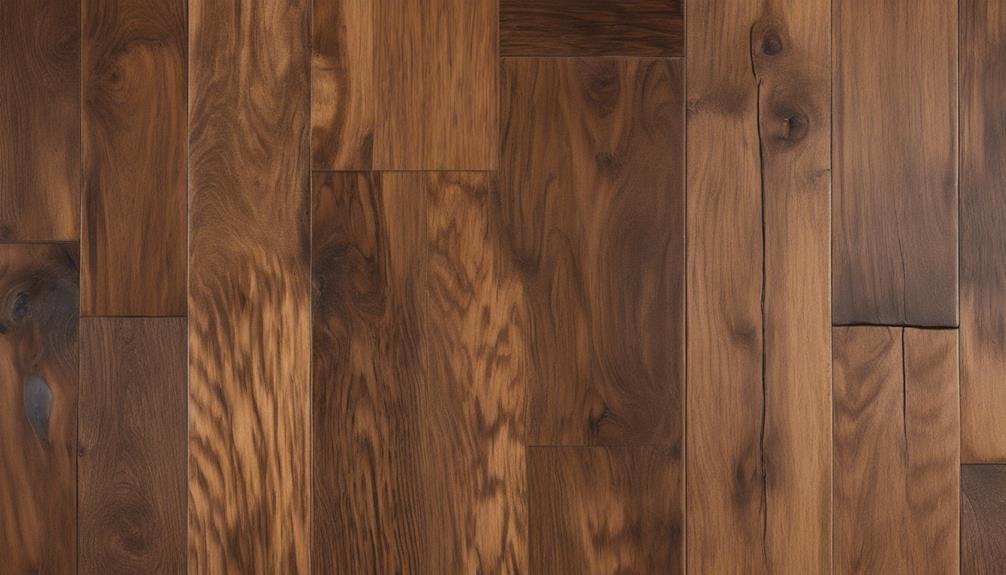
Renowned for its exceptional durability and unmatched strength, hickory emerges as the hardest American wood species, boasting a remarkable Janka hardness rating.
With a high Janka rating ranging from 1820 to 2200, hickory stands out as a top choice for durable flooring options. Its superior resilience against dents and scratches makes it ideal for high-traffic areas like kitchens and living rooms.
Hickory's distinct grain patterns and color variations not only enhance its durability but also add a touch of rustic charm and character to any space. Homeowners favor hickory wood flooring for its timeless aesthetic and long-lasting quality, ensuring that their floors remain both stylish and resilient for years to come.
When seeking a flooring option that combines strength, scratch resistance, and a visually appealing look, hickory proves to be a reliable and enduring choice.
Santos Mahogany: An Exotic and Durable Wood
Emerging as another top contender in the realm of durable wood flooring options is Santos Mahogany, an exotic wood species prized for its exceptional strength and longevity. With its high Janka rating and remarkable hardness, Santos Mahogany stands out as a durable choice for flooring that can withstand the rigors of high-traffic areas. The wood's rich, deep reddish-brown color exudes luxury and adds a touch of elegance and warmth to any space.
Homeowners seeking a premium and long-lasting flooring option often turn to Santos Mahogany for its durability and low-maintenance qualities. This exotic wood not only offers a stunning aesthetic but also provides a practical solution for those looking for a reliable and resilient flooring choice. Whether in residential or commercial settings, Santos Mahogany proves to be a wise investment, combining beauty with functionality in a way that few other flooring options can match. For those desiring a luxurious yet practical flooring solution, Santos Mahogany stands as a top-tier choice.
Frequently Asked Questions
What Type of Wood Flooring Is the Most Durable?
We believe the most durable wood flooring is Brazilian Walnut, known for its high Janka hardness scale rating of 3684. This hardwood option offers exceptional durability and longevity due to its robust nature.
Additionally, Brazilian Walnut is highly resistant to scratches and dents, making it an ideal choice for areas with high foot traffic or potential impact. Its durability makes it a top choice for long-lasting flooring solutions.
What Is the Best Hardwearing Wood Flooring?
When it comes to hardwearing wood flooring, the best choice is often determined by factors like durability, resistance to wear and tear, and maintenance requirements.
Several wood types stand out for their ability to withstand heavy use and maintain their appearance over time.
Consider factors like Janka rating, scratch resistance, and dent resistance when selecting the best hardwearing wood flooring for your space.
What Is the Best Scratch Resistant Hardwood Flooring?
When it comes to finding scratch-resistant hardwood flooring, look no further than Dogwood®. With its innovative densified natural wood and Cleantivity™ antimicrobial coating, Dogwood stands out for its exceptional durability and resistance to scratches.
Brazilian Walnut, boasting a high Janka rating, is another top contender for scratch-resistant hardwood floors. Combining these options with hickory and white oak, Dogwood engineered hardwood offers a winning choice for long-lasting, tough flooring solutions.
What Is the Hardest Wearing Hardwood Floor?
When considering the hardest wearing hardwood floor, it's essential to focus on the Janka hardness rating of the wood species. Brazilian Walnut leads with a Janka rating of 3684, indicating exceptional durability.
Brazilian Cherry follows closely with a rating of 2350, making it a robust option.
Additionally, domestic species like hickory, maple, and white oak offer high durability for hardwood flooring. These choices are excellent for long-lasting and sturdy flooring solutions.
Conclusion
In conclusion, when it comes to choosing the most durable wood flooring types, oak, bamboo, and Brazilian walnut (Ipe) stand out as top contenders. Their strength, resilience, and elegance make them ideal choices for high-traffic areas and spaces that require long-lasting flooring solutions.
For example, a luxury hotel in a bustling city opted for Brazilian walnut flooring in their lobby, withstanding heavy foot traffic and maintaining its beauty for years to come.
Choose durability and style with these top wood flooring options.
- About the Author
- Latest Posts
Introducing Ron, the home decor aficionado at ByRetreat, whose passion for creating beautiful and inviting spaces is at the heart of his work. With his deep knowledge of home decor and his innate sense of style, Ron brings a wealth of expertise and a keen eye for detail to the ByRetreat team.
Ron’s love for home decor goes beyond aesthetics; he understands that our surroundings play a significant role in our overall well-being and productivity. With this in mind, Ron is dedicated to transforming remote workspaces into havens of comfort, functionality, and beauty.
Architecture Home Styles
Make My House Look Less Flat: 10 Easy DIY Tricks
Kick your flat-front house up a notch with these 10 easy DIY tricks that will add depth and character – your home will never look the same!
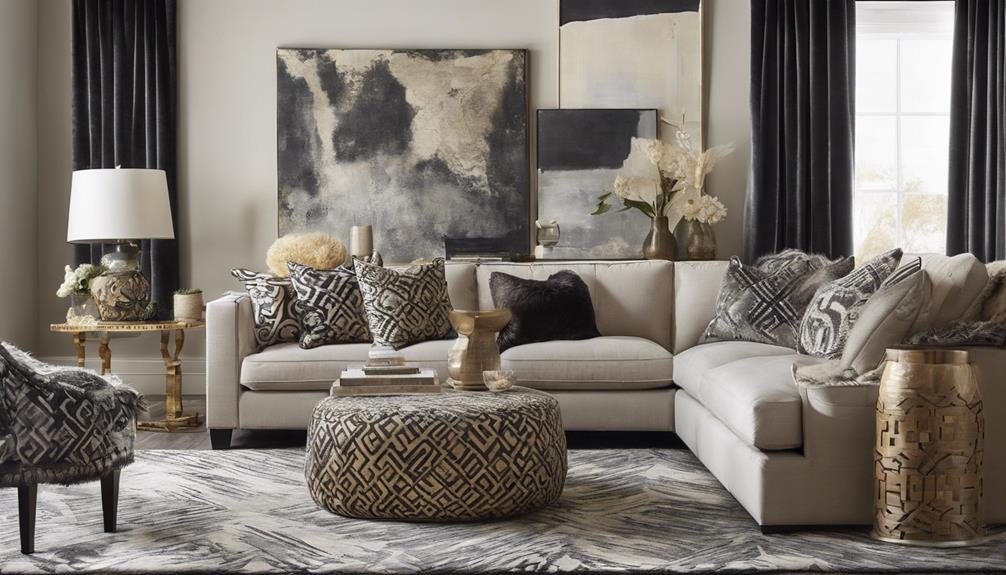
When pondering on how to make our homes appear less flat, we often seek simple solutions that can spruce up our space without breaking the bank.
But what if we told you there are ten easy DIY tricks that can transform your flat-front house into a stylish abode?
From updating light fixtures to revamping the entryway, these tips range from quick fixes to more involved projects, providing a spectrum of options for adding depth and character to your home's exterior.
Key Takeaways
- Upgrade lighting fixtures for a modern and sophisticated ambiance.
- Opt for neutral tones and minimalist decor for a harmonious look.
- Implement budget-friendly updates like faux built-ins and hardware refresh.
- Enhance curb appeal with landscaping, colorful flowers, and strategic lighting.
Update Old Light Fixtures
Let's shed some new light on your space by revamping those outdated fixtures with a modern twist. Upgrading to modern pendant lighting can bring a contemporary flair to your home effortlessly. Swapping out old pendant lights or lamps for sleek, minimalist designs can completely transform the ambiance of a room. By embracing modern pendant lighting trends, you not only illuminate your space but also add a touch of sophistication and style.
Updating light fixtures is a cost-effective way to revamp the aesthetic of any room. Consider mixing different types of light fixtures to create a unique and personalized lighting design that suits your taste. Whether you prefer a bold statement piece or a subtle, elegant fixture, modern pendant lighting offers a wide range of options to choose from. With a simple change in light fixtures, you can elevate the overall look and feel of your space, making it more inviting and visually appealing.
Embrace Neutral Tones
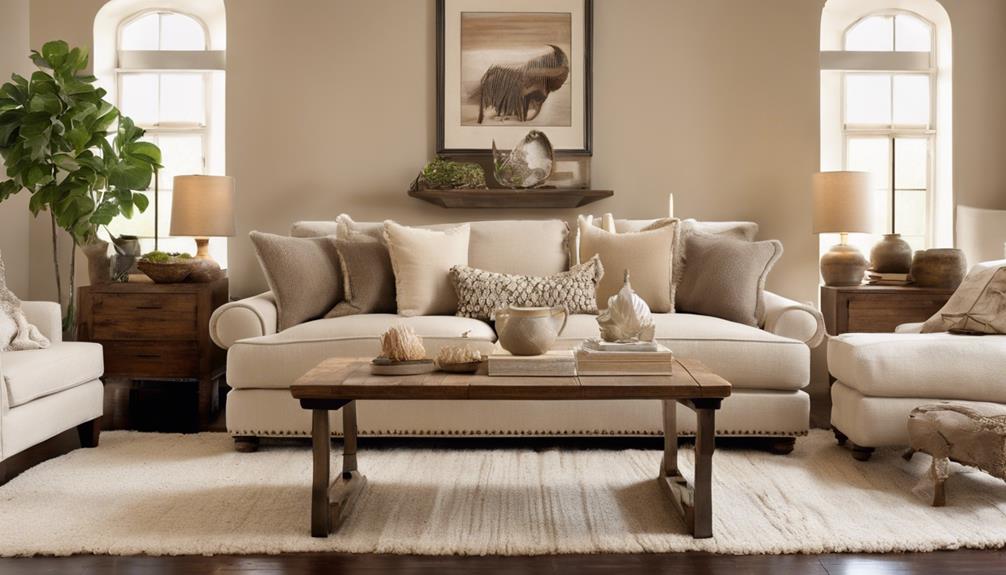
Let's talk about how embracing neutral tones can transform a space effortlessly.
Earthy color palettes and minimalist decor choices can bring a sense of calm and sophistication to any room.
Earthy Color Palettes
Embracing neutral tones in your home decor palette can effortlessly exude sophistication and elevate the overall ambiance of your living spaces. Earthy color palettes, such as warm browns and soft greens, offer a timeless and elegant look that can make your space feel more luxurious.
These natural hues, whether on walls, furniture, or decor pieces, contribute to a sense of tranquility and harmony in your home. By incorporating earthy colors, you can create a high-end design that feels both welcoming and stylish.
Additionally, neutral color schemes make it easier to mix and match furniture and accessories, allowing for a cohesive and polished look throughout your living areas. Experimenting with earthy tones can truly transform your home into a sanctuary of comfort and sophistication.
Minimalist Decor Choices
To maintain the sophisticated and elegant ambiance established with earthy color palettes, our focus now shifts towards the allure of Minimalist Decor Choices accentuated by the embrace of neutral tones.
Embracing neutral colors such as whites, creams, and grays can transform your space into a minimalist haven. These hues have the power to open up a room, creating a sense of airiness and expansiveness.
By integrating neutral tones into your furniture, walls, and decor, you can achieve a clean and cohesive aesthetic that exudes timelessness and elegance. Minimalist decor in neutral shades provides a versatile backdrop that complements any style or theme seamlessly.
The calming and serene atmosphere created by neutral palettes is perfect for those seeking a modern and uncluttered feel in their home.
Create Faux Built-Ins
Enhance your space effortlessly by incorporating faux built-ins using bookcases or DIY bookshelves to create a custom look without the hefty price tag. By mimicking built-ins with strategically placed bookcases, you can add depth and architectural interest to an otherwise flat-front house. Look into IKEA bookshelf hacks and tutorials for cost-effective ideas on achieving the appearance of built-in shelving without breaking the bank.
Consider framing doors or windows with bookcases to give the illusion of custom carpentry work. Placing bookcases on each side of a fireplace or TV can establish a cohesive and visually appealing built-in look. To further enhance the illusion, ensure the bookcases have matching trim and paint colors to seamlessly blend them into the space for a high-end finish. This simple and budget-friendly trick can transform your space, giving it a tailored and sophisticated feel.
Refresh Hardware
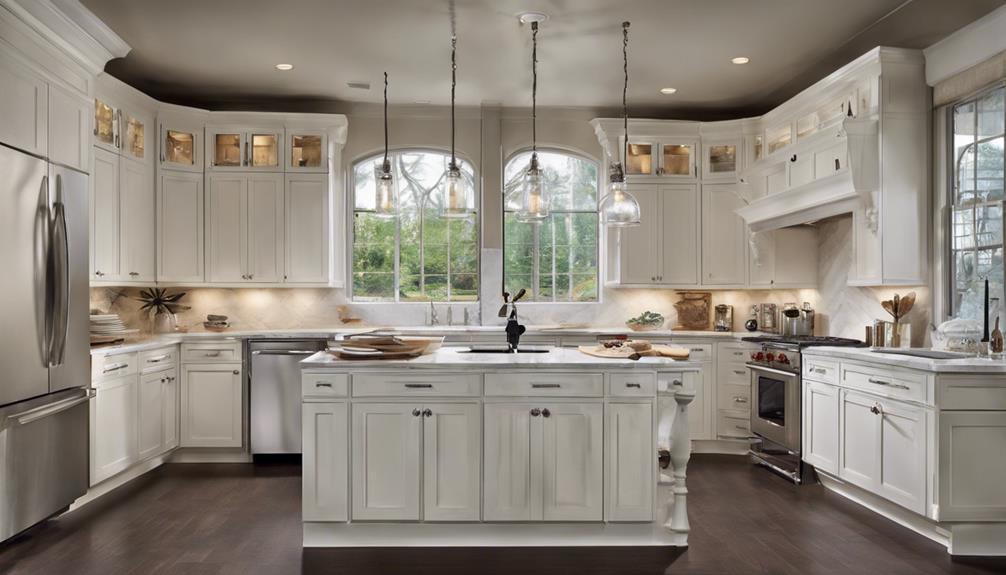
Updating your hardware, such as drawer pulls and knobs, can instantly revitalize the appearance of cabinets and furniture. When it comes to front doors, consider swapping out the old, worn-out hardware for sleek and modern handles or locks. Opting for finishes that complement the overall style of your home, whether it's a stone cottage or a brick townhouse, can significantly enhance its curb appeal. Coordinating the hardware finishes throughout your house creates a cohesive and polished look that ties everything together seamlessly.
In addition to cabinet hardware, don't overlook the impact of refreshing the hardware in other areas of your home. Swapping dated towel bars and hooks in the bathroom for more contemporary styles can elevate the room's aesthetic and bring a touch of luxury. These affordable and quick hardware upgrades offer a cost-effective way to update your home without the need for a major renovation, giving your space a fresh and modern feel.
Enhance Landscaping

Let's elevate the curb appeal of your home by incorporating vibrant perennials and eye-catching mulch to breathe life into your landscaping.
Adding a charming walkway illuminated with pathway lighting can enhance the overall charm of your exterior space effortlessly.
Don't forget to consider budget-friendly options like resin pots and simple shrubs to create a welcoming atmosphere without breaking the bank.
Plant Colorful Flowers
Revamp your flat-front house with a burst of vibrant color by planting a variety of colorful flowers to elevate your landscaping. Adding colorful flowers not only boosts curb appeal but also brings life and charm to your home exterior. By carefully selecting different flower varieties that bloom at various times, you can ensure year-round beauty and interest. Strategic placement of these flowers can create focal points, drawing attention away from the flat facade and towards the natural beauty of your garden. Mix annuals with perennials to enjoy a long-lasting display of colors and textures. Enhance your outdoor space with a palette of nature's hues that will captivate visitors and passersby alike.
| Benefits of Planting Colorful Flowers | |
|---|---|
| Boosts curb appeal | Adds visual interest to the exterior |
| Provides year-round beauty | Creates focal points |
| Draws attention away from flat facade | Ensures long-lasting color appeal |
Add Pathway Lighting
Elevate your home's exterior allure by illuminating the walkway with pathway lighting, enhancing both the safety and aesthetic appeal of your landscaping. Choose from a variety of outdoor light fixtures to add a touch of sophistication and style to your pathway.
Opt for LED pathway lights for their energy efficiency and long-lasting qualities. Solar-powered options aren't only cost-effective but also environmentally friendly. These lights not only guide your way in the dark but also highlight architectural features and landscaping elements, boosting your home's curb appeal.
Experiment With Tiles
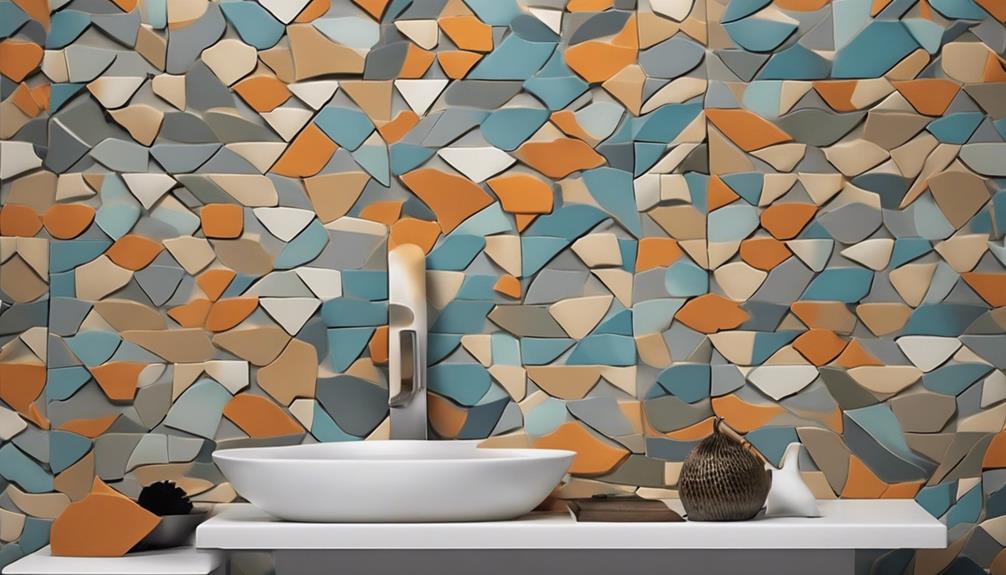
Experimenting with tiles in your home renovation project can bring a touch of sophistication and personality to your space. Here are some innovative ways to incorporate tiles into your design:
- Upgrade Your Kitchen with a Tile Backsplash: Installing a tile backsplash, like classic subway tile, can instantly elevate the look of your kitchen. It's a timeless and cost-effective option that adds a luxurious feel without breaking the bank.
- Create Visual Interest with Patterns and Focal Points: Tiles offer endless possibilities for creativity. Arrange them in unique patterns or use contrasting colors to create eye-catching focal points in your kitchen or bathroom, enhancing the overall aesthetic appeal of the space.
- Play with Shapes, Colors, and Textures: Don't be afraid to mix and match different tile shapes, colors, and textures. This experimentation can add depth and personality to your design, making your home feel more customized and stylish.
Install Decorative Molding
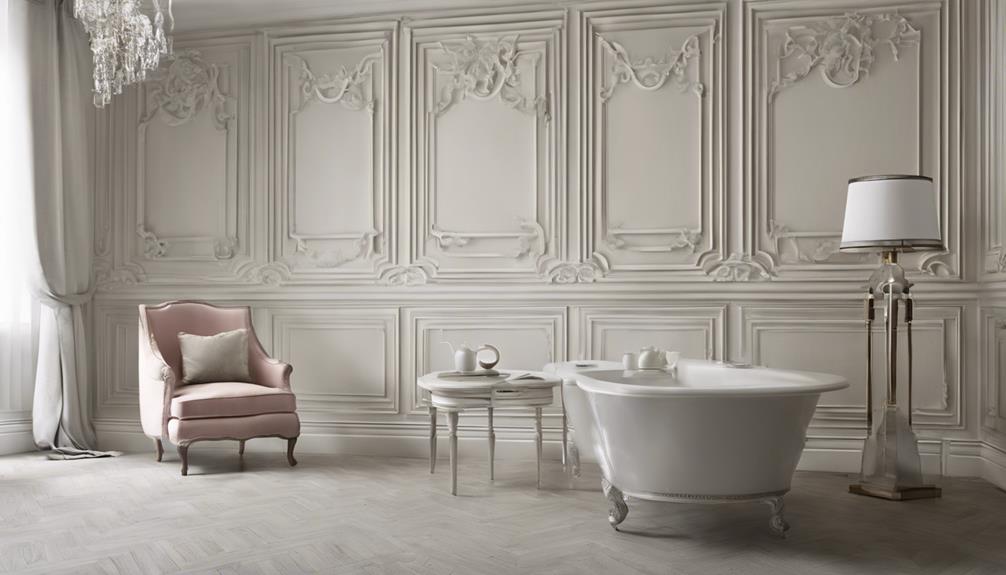
Let's enhance our home's aesthetic appeal by exploring the world of decorative molding.
From crown molding to chair rail molding, each type brings its unique charm to the walls.
We'll guide you on selecting the perfect style and provide expert tips for seamless installation.
Types of Molding
Decorative molding, a versatile design element, encompasses various types such as crown molding, chair rail molding, and baseboard molding, each serving to enhance the aesthetic appeal of walls and ceilings.
- Crown Molding: Adds a touch of sophistication to a room by creating a seamless transition between walls and ceilings.
- Chair Rail Molding: Not only protects walls from scuff marks caused by furniture but also acts as a stylish accent that can elevate the overall look of a space.
- Baseboard Molding: Covers the joint between the wall and the floor, giving a room a polished and finished appearance.
These molding types are essential for adding character and charm to your home with minimal effort.
Choosing the Right Style
As we explore the realm of decorative molding, our focus shifts towards the pivotal task of selecting the right style that will truly elevate the aesthetics of your living spaces.
When considering the front of your house, chair rail molding emerges as a fantastic option. This type of molding not only adds charm and character to your walls but also serves a functional purpose by breaking up large flat areas.
Chair rail molding is versatile and can adapt to different design styles, from traditional to modern, making it a perfect choice for those seeking both visual appeal and practicality.
Installation Tips
To achieve a seamless and professional look when installing decorative molding, consider starting the process by measuring and marking the walls accurately for precise placement. When installing decorative molding, here are some installation tips to keep in mind:
- Use a Miter Saw: Invest in a good quality miter saw to ensure clean and precise cuts for perfect corners.
- Secure Properly: Use a strong adhesive along with nails or screws to secure the molding firmly in place.
- Fill and Sand: After installation, fill any gaps and sand down rough edges for a flawless finish.
With these tips, your decorative molding will enhance the elegance of your space effortlessly.
Revamp Entryway
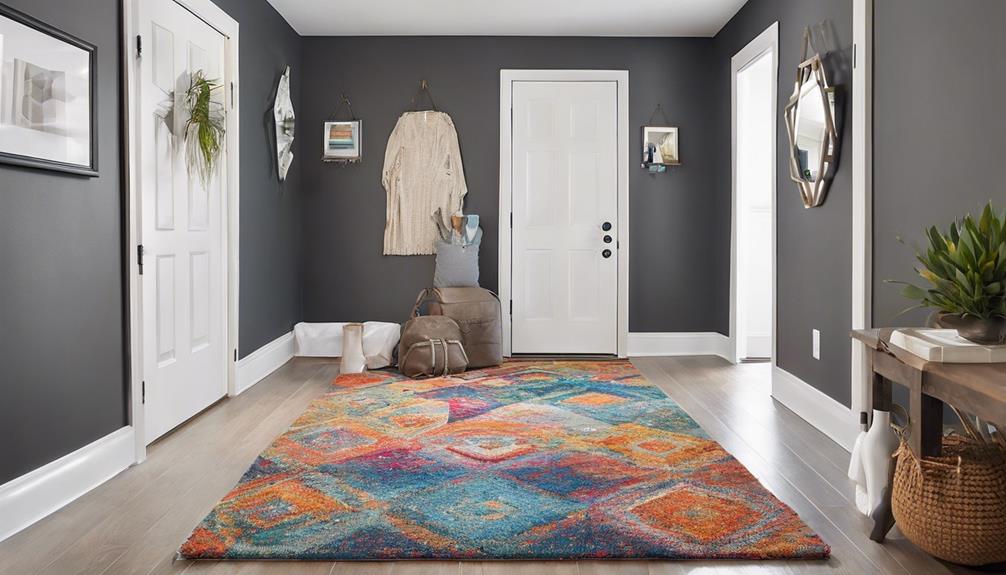
Enhance your entryway with a vibrant pop of color on the front door to instantly draw the eye and create a striking focal point. Choosing a bold color for your front door can completely transform the look of your home's entrance, making it more inviting and stylish. Pair this with colorful flowers, a new welcome mat, or a seasonal wreath to add a welcoming touch that reflects your personality.
In addition to painting the door, consider upgrading the door hardware for a modern look and improved functionality. Stylish lighting fixtures like sconces or pendants can also illuminate and beautify the entryway, creating a warm and inviting atmosphere. To add personality and style, think about installing a decorative mirror or artwork that complements the bold color of the door. These simple DIY tricks can revamp your entryway and make a lasting impression on your guests.
Showcase Artwork
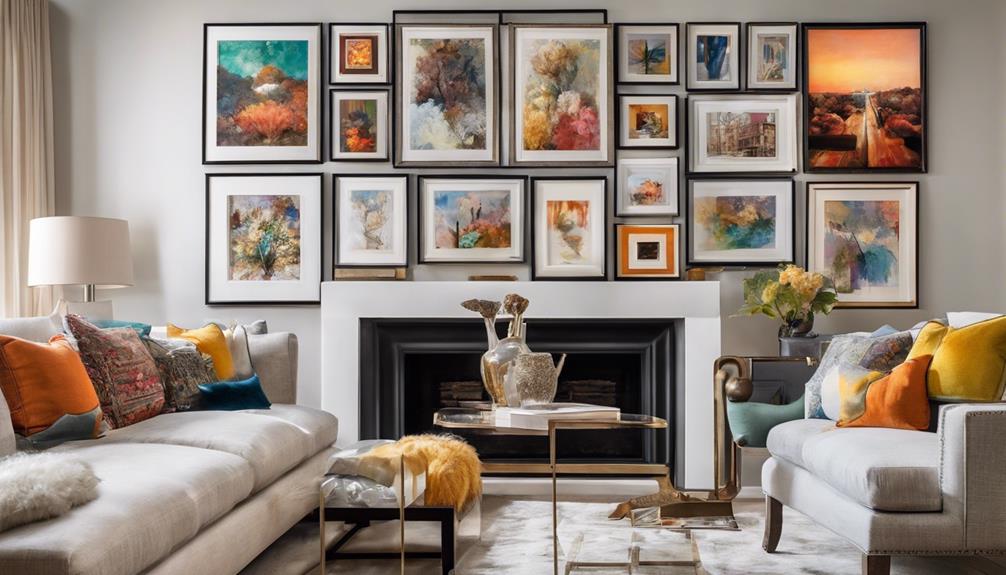
Let's turn our attention now to showcasing artwork as a way to elevate the room's aesthetic and create captivating focal points. When it comes to showcasing artwork, there are various creative ways to make your walls come alive and reflect your unique style.
Here are some innovative ideas to consider:
- Mix and Match: Experiment with different sizes, styles, and types of artwork to add depth and visual interest to your space. Create a custom gallery wall by combining various pieces that speak to you, whether they're paintings, photographs, or prints.
- Curated Display: Consider creating a custom gallery wall with a mix of frames and artwork for a curated look. This approach allows you to showcase a collection of pieces that complement each other while adding personality to your room.
- Personal Statement: Utilize artwork to reflect your personal style and add a touch of personality to the room. Choose pieces that resonate with you and evoke emotions, making your space feel uniquely yours.
Layer Textures
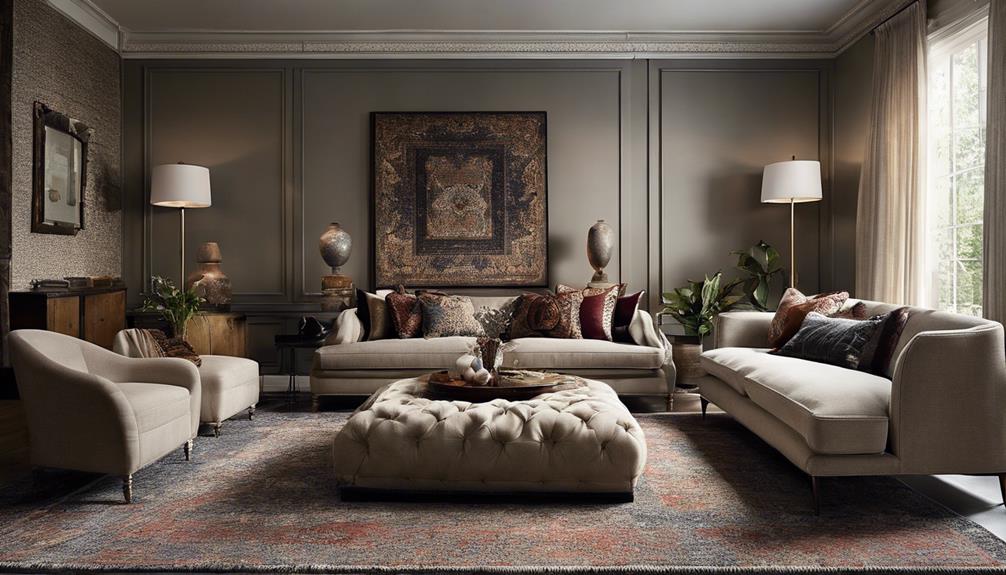
Incorporating a variety of textures in your home decor can instantly elevate the visual appeal of your space, creating a dynamic and inviting atmosphere. To make your house look less flat, layering textures is key. By combining materials like wood, metal, fabric, and glass, you can add depth and interest to your living areas.
Introduce different textures through elements such as throw pillows, rugs, curtains, and wall art to create a more dynamic feel. Consider incorporating luxurious textures like velvet, fur, jute, or leather to bring warmth and sophistication to your rooms. Mixing these textures can transform a flat-looking space into a cozy and visually appealing environment with character.
Experiment with contrasting textures to achieve a curated and stylish look. Embrace the art of layering textures to infuse your home with personality and charm, making it a place you love to spend time in.
Frequently Asked Questions
How Do I Make My House Feel High End?
We can make our house feel high end by incorporating neutral shades for an expensive and sophisticated look.
Updating lighting fixtures with modern pendant lights adds a contemporary touch.
Mimicking built-ins with bookcases creates a luxurious feel affordably.
Replacing hardware like towel bars and drawer pulls provides a quick and inexpensive update.
Adding a tile backsplash, especially subway tile, can give the kitchen an expensive look in a cost-effective way.
How Can I Make My Plain House Look Better?
We can make our plain house look better by adding shutters or awnings for dimension. Enhancing front steps and creating a walkway to the door can boost appeal.
Incorporating brick or flagstone adds texture. Professional landscaping with front gardens elevates curb appeal.
These improvements transform the exterior, making our home more inviting and visually appealing. By implementing these changes, our plain house can become a standout in the neighborhood.
How Can I Spruce up My House?
We can spruce up our house by adding dimension with shutters or awnings. Enhancing front steps for a better look is another great idea. Creating an inviting walkway to the entrance can also make a big difference. Incorporating textured elements like brick or flagstone adds character. Investing in professional landscaping with front gardens can further elevate the appearance of our home.
These simple yet effective DIY tricks can significantly enhance the overall appeal of our home and make it stand out in the neighborhood.
How Can I Decorate My House With Simple Things?
When decorating our house with simple things, we focus on creating a cozy and inviting atmosphere. By incorporating elements like colorful throw pillows, stylish rugs, and unique wall art, we effortlessly elevate our living space.
These small additions bring personality and character to each room, making our house feel like a warm and welcoming retreat. By combining these simple touches, we transform our space into a haven that reflects our style and creativity.
Conclusion
As we put the finishing touches on our flat-front house transformation, we can't help but feel a sense of excitement and anticipation. Each DIY trick we've implemented has added layers of character and charm to our home, setting the stage for a stunning reveal.
Stay tuned as we unveil the final look, showcasing how a little creativity and effort can truly make a house feel like a work of art. Get ready to be amazed!
- About the Author
- Latest Posts
Introducing Ron, the home decor aficionado at ByRetreat, whose passion for creating beautiful and inviting spaces is at the heart of his work. With his deep knowledge of home decor and his innate sense of style, Ron brings a wealth of expertise and a keen eye for detail to the ByRetreat team.
Ron’s love for home decor goes beyond aesthetics; he understands that our surroundings play a significant role in our overall well-being and productivity. With this in mind, Ron is dedicated to transforming remote workspaces into havens of comfort, functionality, and beauty.
-
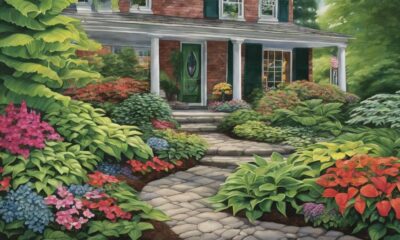
 Vetted21 hours ago
Vetted21 hours ago15 Best Plants to Thrive on the North Side of Your House – A Gardener's Guide
-

 Vetted1 week ago
Vetted1 week ago15 Best Boxwood Varieties for Thriving in Full Sunlight
-

 Vetted2 weeks ago
Vetted2 weeks ago15 Best Ways to Label Clothes for Nursing Home Residents – Stay Organized and Efficient
-

 Decor3 days ago
Decor3 days agoAre Home Decor Stores Profitable?
-

 Vetted1 week ago
Vetted1 week ago15 Best Dryer Vent Hoses to Keep Your Laundry Room Safe and Efficient
-

 Vetted1 week ago
Vetted1 week ago14 Best Cleaners for Aluminum Surfaces – Shine Bright Like a Diamond
-

 Vetted1 week ago
Vetted1 week ago15 Best Spider Sprays to Keep Your Home Arachnid-Free
-

 Vetted1 week ago
Vetted1 week ago15 Best Nightstand Charging Stations to Keep Your Devices Organized and Ready to Go








